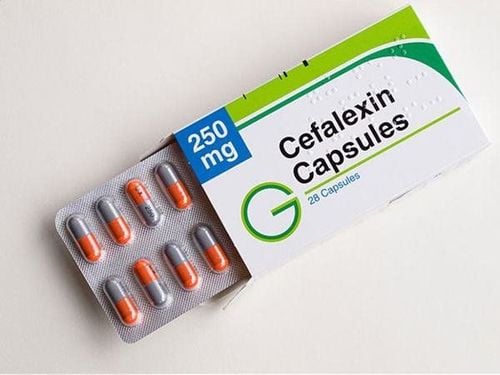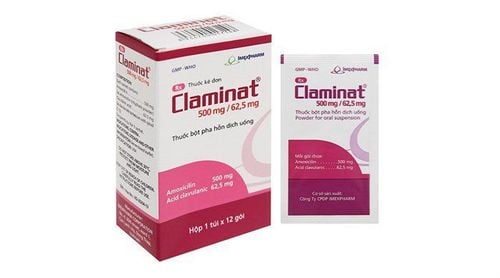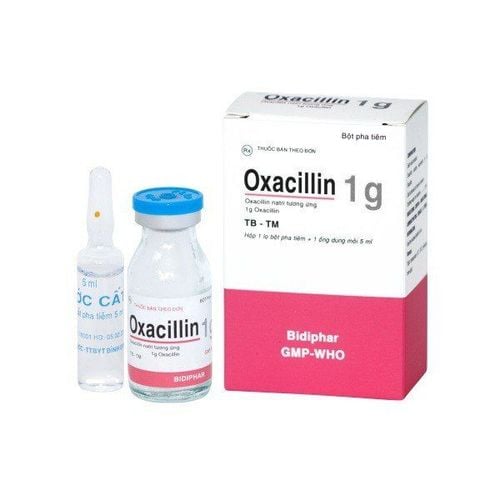This is an automatically translated article.
Cubicin antibiotics are a new group of antibiotics, which mainly affect gram-positive bacteria, including bacteria resistant to some previous strong antibiotics such as vancomycin, methicillin. To learn more about the antibiotic Cubicin, please refer to the article below.
1. Effect of Cubicin
Cubicin drug has the main ingredient Daptomycin 500mg, prepared in the form of lyophilized powder for intravenous infusion. Daptomycin is an antibiotic, used to treat bacterial infections. Daptomycin is an antibiotic in a new class of antibiotics, called cyclic lipopeptides. Daptomycin is a natural product used clinically in the treatment of infections caused by gram-positive bacteria. Daptomycin is active against most gram-positive bacteria resistant to other antibiotics, including strains resistant to the antibiotics methicillin, vancomycin and linezolid.The mechanism of action of daptomycin is different from that of other antibiotics. Daptomycin binds to bacterial cell membranes thereby causing rapid depolarization of the cell membrane potential in the stationary or growth state. Loss of membrane potential inhibits protein, DNA and RNA synthesis resulting in bacterial cell death.
2. Indications and contraindications of Cubicin
Cubicin is indicated for the treatment of serious infections caused by susceptible bacteria, including:
Complicated skin and skin structure infections caused by susceptible gram-positive bacteria such as Staphylococcus aureus (including methicillin-resistant Staphylococcus aureus), Streptococcus pyogenes, Streptococcus agalactiae, Streptococcus dysgalactiae under the species equisimilis, and Enterococcus faecalis (vancomycin-susceptible groups). Staphylococcus aureus bacteremia, including infective endocarditis caused by organisms susceptible and resistant to methicillin. Treatment with this drug for infections can be combined with other organisms if both gram-negative or anaerobic bacteria are suspected. Do not use Cubicin in the following cases:
If you are allergic to the active ingredient Daptomycin or any other drugs. Do not get vaccinated while using Cubicin unless your doctor tells you to.
3. Dosage and how to use Cubicin
3.1 How to take Cubicin is given by intravenous infusion. The infusion is carried out by medical personnel. The steps to administer the injection are as follows:
The drug is provided in a vial containing 500mg of daptomycin as a sterile lyophilized powder. Open the pop cap from the Pill vial to expose the center part of the rubber cap. Inject 10 mL of 0.9% sodium chloride injection slowly through the center of the rubber stopper into the vial, pointing the needle against the wall of the vial. Make sure all of the medicine in the vial is wet by gently rotating the vial. To minimize foaming, vigorous shaking of the vial should be avoided during and after reconstitution. Hold the vial for 10 minutes. Gently swirl the vial for several minutes, as needed, for the solution to dissolve completely. After reconstitution, the drug should be further diluted with 0.9% sodium chloride injection solution for intravenous infusion over about 30 minutes. Storage: Stability studies have shown that the reconstituted solution is stable in the vial for 12 hours at room temperature or up to 48 hours if refrigerated at 2-8 degrees C. The diluted drug solution is stable in the infusion bag for 12 hours at room temperature or 48 hours when stored under cold conditions. Intravenous drugs should be visually inspected for foreign particles prior to use. Other drugs should not be added to a single-use vial or infused with Cubicin. When the same infusion set is used in succession for different drugs, it is recommended that the infusion set be rinsed with compatible infusion solution before and after infusion. 3.2 Dosage Complicated Skin and Skin Structure Infections: The recommended adult dose is 4 mg/kg, administered once every 24 hours for 7-14 days or until the infection clears. Staphylococcus aureus sepsis, including right endocarditis: The recommended adult dose is 6 mg/kg, administered once every 24 hours for 2-6 weeks depending on the diagnosis of the treating physician. treat. Renal failure: Daptomycin is eliminated mainly by the kidneys. Therefore, it is necessary to adjust the dose accordingly when necessary. Patients with creatinine clearance ≥ 30 mL/min: No dose adjustment is usually required. Close monitoring of response to treatment and renal function is required for almost all patients with renal impairment. Patients with creatinine clearance <30mL/min: Need to increase the interval between doses up to 48 hours for each single dose. Close monitoring of clinical response to therapy and renal function is required in these patients. Adjust dose for patients undergoing hemodialysis or continuous outpatient peritoneal dialysis. When possible, the drug should be administered after completion of the day's dialysis. Hepatic Impairment: No dose adjustment is required when used in patients with mild or moderate hepatic impairment. There are no data in patients with severe hepatic impairment. Elderly Patients: The recommended adult dose should be used in elderly patients with the exception of patients with severe renal impairment. Children and adolescents (< 18 years of age): The efficacy and safety of this drug have not been established at this time.
4. Undesirable effects of Cubicin
Side effects of the drug that you may experience include:
Anemia , eosinophilia, thrombocytopenia; supraventricular arrhythmias; dizzy. Digestive disorders such as abdominal pain, constipation or diarrhea, indigestion, nausea, vomiting. Fatigue, reaction at the infusion site, fever, chills, weakness; jaundice. Infections caused by non-susceptible bacteria such as fungal infections, urinary tract infections. On laboratory tests: Electrolyte imbalance, CPK increase; increased creatinine; abnormalities in liver function tests such as increased AST, ALT, and alkaline phosphatase; increased lactic dehydrogenase (LDH). Metabolism and nutrition disorders: causing decreased appetite, increased blood sugar. Joint pain, muscle pain, muscle weakness; headache, paresthesia, taste disturbance; anxiety, insomnia; CKD; vaginitis. Rash, itching, urticaria; hot flashes, hypertension, hypotension; Some other side effects: lymphadenopathy, thrombocytopenia; jitter; atrial fibrillation, atrial flutter, cardiac arrest; indigo; abdominal distension, flatulence, stomatitis; eye irritation, blurred vision; digestive disorders such as dry mouth, epigastric discomfort, sore gums, decreased sensation in the mouth; increase alanine aminotransferase, increase aspartate aminotransferase,...
If during the course of taking the drug you see any abnormal signs suspected of taking the drug, you should immediately report it to a medical staff for support.
5. Things to keep in mind when using Cubicin
Antibiotics are only used for bacterial infections and prescribed by a doctor. To minimize the development of resistant bacteria and maintain the effectiveness of Cubicin and other antibiotics, it should be used only for the treatment or prevention of infections with known or likely causes. produced by drug-sensitive bacteria. To ensure this, the drug should be administered according to the results of the antibiogram. When taking the drug can cause the growth of fungi or bacteria that are not sensitive to this organism. If you notice signs of a fungal infection on your tongue, genitals, or severe diarrhea, call your doctor immediately. The drug is known to be excreted in human milk in very small amounts, but use with caution if you are breastfeeding or pregnant. Pregnant and nursing women should ask their doctor about the risks and benefits of the drug. Patients with persistent or recurrent Staphylococcus aureus infection or poor clinical response to the drug should have repeated blood cultures. If blood cultures are positive for Staphylococcus aureus, susceptibility testing should be performed, as well as diagnostic reevaluation to rule out other unidentified foci of infection. To choose the right antibiotic. Drug interactions: Some drugs can cause drug interactions including the statin drug Atorvastatin; Fluvastatin; Lovastatin; Pravastatin; Rosuvastatin; Simvastatin. The above is the information about Cubucin drug, the use of the drug should be done under the doctor's consideration, should only be used when the existing antibiotics have few side effects and are not effective.
Please dial HOTLINE for more information or register for an appointment HERE. Download MyVinmec app to make appointments faster and to manage your bookings easily.













